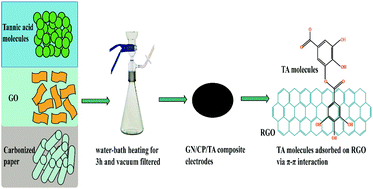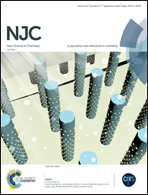Synthesis and characterization of graphene/carbonized paper/tannic acid for flexible composite electrodes
Abstract
A simple and low-cost approach toward flexible and free-standing electrodes is developed. Ternary composites of graphene/carbonized paper/tannic acid (GN/CP/TA) with various ratios were fabricated via a facile vacuum-filtration process. Through carbonization of widely used paper, the obtained carbonized paper possessed a good pore structure and an ion transport channel. Tannic acid (TA) can enter into the layers of graphene sheets and prevent graphene sheets from agglomerating by suppressing the π–π stacking interactions. Different amounts of tannic acid increased the distance between graphene sheets, facilitating the formation of GN/CP/TA composite electrodes without metallic current collectors, binders and additives. The optimal ratio (GN/CP/TA2) was determined and the composite electrodes displayed a high area specific capacitance of 530.2 mF cm−2 with a mass of 2.85 mg cm−2 (specific capacitance of 186 F g−1) at 0.2 mA cm−2. The composite electrode had good mechanical flexibility (about 82.94% retention in capacitance after 500 bending times) and prominent cycling stability (86.62% retention in capacitance over 10 000 cycles). Moreover, the device can achieve a superior energy density of 36.82 μW h cm−2 and a maximum power density of 1372.73 μW cm−2. These results demonstrated that the composite film was a promising electrode material and may be useful for the development of flexible high-performance and wearable energy storage devices. More importantly, this strategy provided a facile method for the fabrication of other types of composite film electrodes.



 Please wait while we load your content...
Please wait while we load your content...